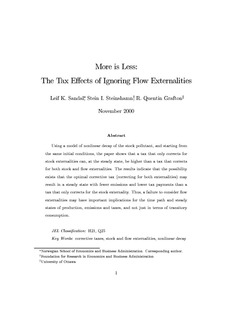| dc.contributor.author | Sandal, Leif Kristoffer | |
| dc.contributor.author | Steinshamn, Stein Ivar | |
| dc.contributor.author | Grafton, R. Quentin | |
| dc.date.accessioned | 2006-07-14T10:28:02Z | |
| dc.date.available | 2006-07-14T10:28:02Z | |
| dc.date.issued | 2000-11 | |
| dc.identifier.issn | 1500-4066 | |
| dc.identifier.uri | http://hdl.handle.net/11250/164051 | |
| dc.description.abstract | Using a model of nonlinear decay of the stock pollutant, and starting from the same initial conditions, the paper shows that a tax that only corrects for stock externalities can, at the steady state, be higher than a tax that corrects for both stock and flow externalities. The results indicate that the possibility exists that the optimal corrective tax (correcting for both externalities) may result in a steady state with fewer emissions and lower tax payments than a tax that only corrects for stock externality. Thus, a failure to consider flow externalities may have important implications fior the time path and steady states of production, emissions and taxes, and not just in terms of transitory consumption. | en |
| dc.format.extent | 1980195 bytes | |
| dc.format.mimetype | application/pdf | |
| dc.language.iso | eng | en |
| dc.publisher | Norwegian School of Economics and Business Administration. Department of Finance and Management Science | en |
| dc.relation.ispartofseries | Discussion paper | en |
| dc.relation.ispartofseries | 2000:21 | en |
| dc.subject | corrective taxes | en |
| dc.subject | stock and flow externalities | en |
| dc.subject | nonlinear decay | en |
| dc.title | More is less : the tax effects of ignoring flow externalities | en |
| dc.type | Working paper | en |
